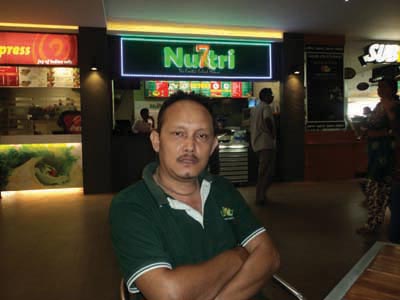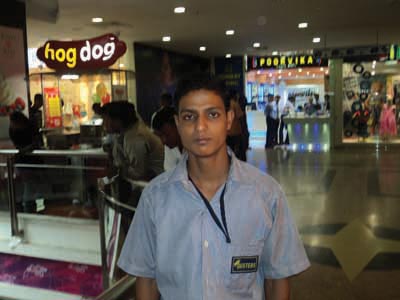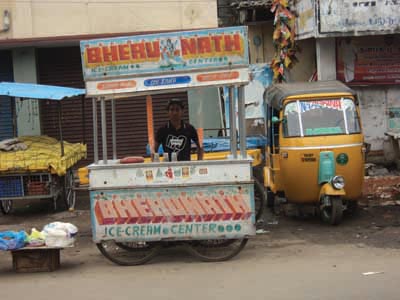
Workers from different States board a bus at Choolaimedu to work on the MRTS line. |
Chennai has a large migrant population, which mainly comes from other parts of Tamil Nadu. In 2001, out of the 937,000 migrants (21.57% of the city’s population), 74.5% were from other parts of the State, 23.8% were from rest of India and 1.7% were from outside the country, according to a study by M. Amirthalingam. The second figure would have changed considerably, judging by the number of out-of-State persons I have come across working here in a variety of occupations.
In his 20s, Pradeep of Allahabad runs a paan stall in a busy market area in central Chennai. While some of his customers take his fresh gutkha, crushed areca nut, paying him in loose change, others ask and get it for free. Speaking a smattering of Tamil, he laughs at such freeloaders. All the ingredients of his juicy meetha (sweet) paan are from outside the State, he informs me in Hindi. Though he has cultivable land back in U.P., he says that he has no sense of pride in farming or even running a paan stall near his home. Here he has no time for leisure.

Workers from West Bengal and Bihar working on the Koyambedu grade separator. |
Less than a five-minute walk away are the brothers Alok and Sandeep Pandey, paanwallas from Varanasi. Speaking to the younger of the two, I learn that work takes all his time, and entertainment is only watching television.
Shy and reticent, Sachin sells cotton candy at one of Chennai’s beaches. He waves a bell to hawk his wares as he strolls along. He stays in Little Mount, but is from UP.
Rajesh has a refrigerated box mounted on a four-wheel cycle to sell his kulfi and badam milk. He is from Bhilwara in Rajasthan. And the lanky Kallu from Mahoba District in UP sells pani puri on one of the roads leading to the beach off East Coast Road. On the busy road opposite the Kapaleeswarar tank is another youth from his State, Rahul from Kanpur, also selling pani puri.
Sateesh and Rahul work at the Pazhamudir Nilayam juice shop in Anna Nagar West. They belong to Chhindwara District in Madhya Pradesh, but have been here for two years.
A restaurant owner, who set up in NSC Bose Road, has now moved to Kelly’s. He says his kitchen staff are from Garhwal in Uttarakhand, Maharashtra and Nepal, and the cleaners from Bihar.

Akash from Darjeeling in food business here for 17 years. |
Toy vendor Mohamad Robial (many, including Mohamad, were able to spell their names for me in English) from Assam sells plastic choppers in the subway near Central Station. He sources them from the city itself, and says he goes to wherever business is good. He has also sold his toys in Kerala. He too speaks Tamil.
Jessica, a salesgirl, and John are from Manipur and are working in a jeans showroom and a salad outlet respectively at a glitzy mall. Jessica has cousins and friends in the city.
S.K. Pradhan from Orissa started working as a security guard in a mall under construction and has continued to work there for the past four years. Mohan Miah is a sweeper in the same mall, but he has only recently come from Tripura.
At the site of a neighbourhood hospital, where renovation is going on, I met several workers from out of State. The youngest and most garrulous was Ravi from Siliguri, near Darjeeling. Nothing of any consequence ever happened in his hometown, he said. Here, he is gaining experience in masonry and can soon work as a maistry. The others are Naidu from Andhra Pradesh, Rakesh from Orissa and Thomas, who is an electrician, is from Goregaon near Mumbai. Thomas has been moving from site to site from Delhi to Goa to Chennai.

Mohan Miah from Tripura, working in a city mall. |
Shyamalal Das and Sandeep Das are two young Assamese security guards at a workers’ colony in Nandambakkam. They told me they are in the city less than a year and have not been able to stir out of the neighbourhood, because they have 12-hour duty shifts.
Masroor and Abu Nasar belong to Araria zilla in Bihar and work as electrical helpers. They wish to gain experience so as to work in foreign countries “where we can earn more money.” They had worked as zari workers earlier.
Mohd Samir from Malda District in West Bengal does marble floorings. He has been here for the past two years, and had previously worked in Orissa.
The project manager of Simplex Infrastructures, which is building the Koyambedu flyovers, told me that its workers were skilled and moved along with the company’s projects.
Bicky Sharma and Dasarath, not colleagues, are from Gorakhpur District, U.P. Bicky, whom I met while travelling in a bus from Guindy, is a carpenter, and has been in Chennai for two years. He stays in Otteri and spends 20 rupees commuting to work and back but saves enough money to send home. He has absolutely no time for leisure. The bus conductor said these workers, who almost fill the bus on certain routes, are very sharp and have a working knowledge of Tamil.
Kumar and Roop Singh from Chhatisgarh are construction workers laying slabs in MRTS stations near Indira Nagar. There are workers from Jharkhand too.

Rajesh from Bhilwara, Rajasthan, in the flavoured milk business. |
Meghnath and others work on the airport expansion site of Consolidated Construction Company in Meenambakkam. He is from West Bengal, but his co-workers are from other states, like Bihar. They had earlier worked in buildings constructed by DLF at Ramapuram and a 7-Star Hotel project at MRC Nagar.
Abhishek, an employee of Tata Consultancy Services, says very few people in Chennai speak Hindi and he has had to take the help of colleagues while attending to the nitty-gritty of settling down here.
Giving his perspective on the “rampant labour migration across the country,” Prof. C. Lakshmanan of the Madras Institute of Development Studies says people from the southern States go up north. The reasons he outlines are the step-motherly treatment given by governments to agriculture and false expectations that the labour class may have about the jobs they are to be employed in. Once they start working, they are paid wages for eight hours but work for 12 hours.
Architect Durganand Balsaver says awareness levels among the youth have increased and they would rather work in lower paying jobs than put in much harder work at construction sites.
I can’t help but conclude by stressing the fact that Cinema in Chennai has opened its arms to northern influence. Singer Udit Narayan, a Bihari, has sung more than 75 songs in Tamil films over a decade and more!
Back to top
|